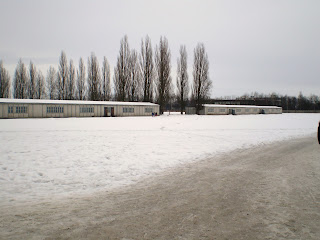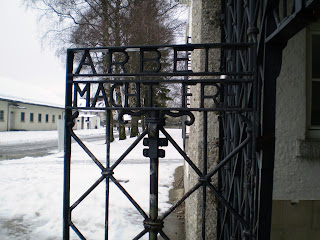On our final full day in Munich, Garnet and I ventured outside the city to visit the Dachau Concentration Camp. If you visit Munich, I highly recommend that you set aside at least half a day to visit this memorable landmark. It is very easy to travel to using the metro system and the S Bahn (above ground train), and there is a free bus every ten minutes from the train station to the camp. Entrance to the grounds is free; the only fee being a minimal 2.50€ for the audio guide.
The Dachau Concentration Camp was the first concentration camp established by the Nazi party in WWII and acted as a model for other camps that followed. It began housing prisoners in 1933 for political reasons, and at the outset of the war began imprisoning "undesirables" from conquered lands. Nazi propaganda portrayed Dachau as a camp where these prisoners were receiving "re-education." Over 30,000 deaths were recorded by Dachau administration, but this does not include numbers from the death marches held shortly before liberation, prisoners who died after liberation due to their weakened state, or the huge amounts of inmates who died after being transferred to other concentration camps. The true number of deaths caused by Dachau will likely remain unknown forever.
The barracks within the camp were designed for 6,000 inmates, and at the time of liberation by Americans in 1945 there were a reported 32,000 survivors in the camp. Over the course of the war, conditions within the camp progressively decreased until German officers were actually instructed to improve living situations in 1942 to reduce the amount of deaths. However conditions did not improve substantially because in 1945 overcrowding, malnutrition and starvation caused Typhus outbreaks.
Structurally, the modern Dachau camp is not the same as in WWII. The entrance gate and fencing remain, as well as the jail bunker, but only two of the original inmate barracks survive. The inscription on the metal entrance gate states ominously that "work sets you free." The large maintenance building has been converted into a museum, which in addition to educational displays houses a theater for the filming of a short documentary. There are several memorials on site, including buildings dedicated to Jewish, Catholic, Protestant and Russian Orthodox faiths.
This memorial relief depicts figures caught in the fence.
Just outside the fenced grounds are two infamous crematorium buildings; the second built because the first could not handle the increasing number of bodies. The second crematorium includes a gas chamber, but this room was never evidently used for mass murders (though it may have been used for tests). Around the crematoriums lay several grave stones honouring the locations of the deceased.
Our visit to Dachau was an incredibly moving experience, and despite spending five hours there we still could not fathom the atrocities which took place. It had been a warmer day, and the melting snow was soaking and freezing our feet, but we dared not complain given our surroundings. Cold feet do not come close to comparing to the suffering experienced at Dachau. The details I have shared in this blog only scratch the surface of the mass of knowledge we gained from our visit. It is best to experience the camp in person, to see the buildings, walk the grounds and listen to the personal accounts on the audio guide. When I reflect on my trip in years to come, I am confident that my visit to Dachau will remain unforgettable, as it should.
On a happier note, we perfectly paired our Dachau experience with the much more light-hearted BMW museum. The BMW headquarters occupies a large area of land located very near the Munich Olympic grounds. The museum is a completely impressive depiction of innovation, technology and lots and lots of money. The building is very modern with lighted walls and sloping walkways. At the center of the museum, a spirally path large enough for a car winds its way up through the floors. Some of the fascinating technological elements included a room-sized table with touch-screen capabilities outlining the history of BMW, ceiling speakers which read books as you turn the page, and direction-based floor sensors which talk about the display you face. You do not have to have a specific interest in BMW to find this museum amazing. I'll let my pictures do the rest of the explaining.
Shannon















Who would have guessed you had to click "no comments" to comment!
ReplyDeleteYou packed a lot of learning into a dozen days of travel! So glad you're sharing.
Mom